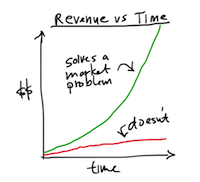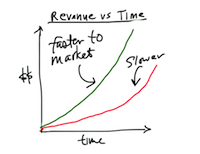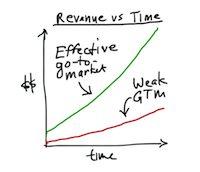Is product management the most overlooked market opportunity for software right now? Nils Davis, BoS attendee, is throwing down the gauntlet:
Most of you have the ambition to get big. How do you do that? The only way to get big as a product company is for people to buy your product. Preferably a lot of people, for significant amounts of money at a time. Duh!
But why would people buy your product? We know there are products that people don’t buy. We don’t want those – because you can’t get big, or even grow at all. If you look at the revenue line for a product that no one buys – it’s nasty! We don’t like that line at all!
Why Do We Get Revenue?
Compare it to our desired revenue line – up and to the right – and accelerating as it goes up. If our product sells like that, it means it’s solving an important problem for some people – important enough that people will pay for the solution.
You can have a beautiful product, beautifully engineered and architected, and totally rocking in usability – but if it doesn’t solve a big market problem. Flat line.
But a product can have some warts, not quite work as the user expects all the time, have some typos, use a 1998 style UI – but if it solves a big problem better than anything else. Up and to the right.
Problem Should Be At The Center
This is called, in Lean, “product/market fit,” or “finding a repeatable business model,” or other things. These terms kind of still assume the product is at the center. But in truth the market problem should be at the center. That’s what drives your revenue up and to the right – a good market problem that only you solve, or that you solve better than anyone else.
Or… Product Management
There’s a person in your company, perhaps multiple people, who are responsible – or should be – for finding these problems and figuring out to solve them. If you’re a small startup, this is going to be one of your founders. In a larger company, that person is usually called a “product manager.” (Perhaps this role should be called “problem manager?”)
The Rest Of The Story
Apart from finding the problem, there are two other important things product managers do as well – less important in some sense (doing a better job of building a zero-revenue product still leaves you with zero) – but still necessary for success.
One of these is to guide the creation of the solution. This happens differently at different companies – sometimes the PM creates a full spec, sometimes a tweet is good enough to guide the engineering team. But it’s the responsibility of the PM to make sure that what comes out solves the market problem.
The third critical piece is to get the product to market. Making sure that the right people in the market know about it, that the sales force knows how to reach those people and sell it to them. Remember, those people are anxious for a solution and willing to pay for it.
“What Does A Product Manager Do?” – A Better Answer
When someone asks you in the future “What does a product manager do?,” instead of saying “he or she is the CEO of the product,” you can say they:
• Find a market problem (and validate it)
• Create a solution to the problem
• Take it to market
The Business Value of making PMs More Effective
I’m looking at – and building – tools and content to support product managers in doing a better job, in making them more effective in doing those steps. There’s a big reward for doing this better!
The business value of a product manager is about $10 million. This is what the market says. Software companies generally have one product manager for every $10 million in forward-looking revenue.
(Can you go out and magically add $10 million in revenue by hiring a product manager? Not necessarily – for example, if that new revenue is going to come from a new product, you’ll also have to hire a few engineers – about one engineer for each $1 million in forward-looking revenue.)
But just as you expect a new sales person to add some significant percentage of his or her quota to the top line after a certain ramp up period, you expect some revenue impact from adding a product manager.
Improving PM Effectiveness
Can we increase this? What if product managers were 10% more effective? That makes a product manager worth $11 million – $1 million more, which would be nice. Move the revenue line up, moves it to the left… There are lots of possibilities.
The Opportunity
Here’s a little tidbit about the opportunity:
PM is the only organization in the enterprise that’s not automated.
We are using tools designed for finance, for marketing, for documentation, or developers, and we lack tools that really address our needs – finding a market problem, creating a solution, and taking it to market.
Even the best requirements management tools only touch a tiny bit of what PMs do – and they have their limits even in that small domain.
Litmus Test
So here is the litmus test for your product manager:
You should be able to:
• Articulate the problem you’re solving for your market segment
• Articulate the (terrible) way they are solving this problem now without your product
• Validate how much this problem is worth to them to solve, and how big the market is for the solution
If you can do those things, you’re well on your way to having that up-and-to-the-right experience.
Let me know if you have questions or thoughts on improving PM effectiveness, and look me up at the BoS in Boston in September. I’ll be there.
Give Nils some feedback in person at BoS or on Twitter @nilsie. More on his website http://nilsdavis.com.


